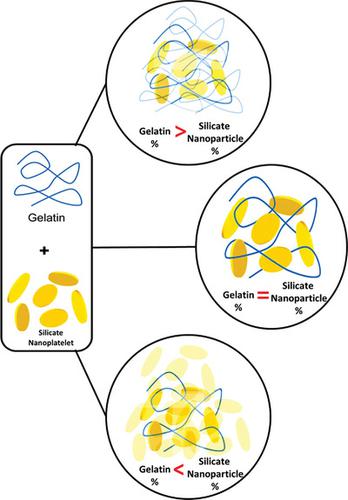当前位置:
X-MOL 学术
›
Biotechnol. J.
›
论文详情
Our official English website, www.x-mol.net, welcomes your
feedback! (Note: you will need to create a separate account there.)
Synthesis of Injectable Shear-Thinning Biomaterials of Various Compositions of Gelatin and Synthetic Silicate Nanoplatelet.
Biotechnology Journal ( IF 3.2 ) Pub Date : 2020-02-27 , DOI: 10.1002/biot.201900456 Chengbin Xue 1, 2, 3, 4 , Huifang Xie 1, 2, 5 , James Eichenbaum 1, 2 , Yi Chen 1, 2, 6 , Yonggang Wang 1, 2, 7 , Floor W van den Dolder 1, 2, 8, 9 , Junmin Lee 1, 2 , KangJu Lee 1, 2 , Shiming Zhang 1, 2 , Wujin Sun 1, 2 , Amir Sheikhi 1, 2, 10, 11 , Samad Ahadian 1, 2 , Nureddin Ashammakhi 1, 2, 12 , Mehmet R Dokmeci 1, 2, 12 , Han-Jun Kim 1, 2 , Ali Khademhosseini 1, 2, 12, 13
Biotechnology Journal ( IF 3.2 ) Pub Date : 2020-02-27 , DOI: 10.1002/biot.201900456 Chengbin Xue 1, 2, 3, 4 , Huifang Xie 1, 2, 5 , James Eichenbaum 1, 2 , Yi Chen 1, 2, 6 , Yonggang Wang 1, 2, 7 , Floor W van den Dolder 1, 2, 8, 9 , Junmin Lee 1, 2 , KangJu Lee 1, 2 , Shiming Zhang 1, 2 , Wujin Sun 1, 2 , Amir Sheikhi 1, 2, 10, 11 , Samad Ahadian 1, 2 , Nureddin Ashammakhi 1, 2, 12 , Mehmet R Dokmeci 1, 2, 12 , Han-Jun Kim 1, 2 , Ali Khademhosseini 1, 2, 12, 13
Affiliation

|
Injectable shear‐thinning biomaterials (iSTBs) have great potential for in situ tissue regeneration through minimally invasive therapeutics. Previously, an iSTB was developed by combining gelatin with synthetic silicate nanoplatelets (SNPs) for potential application to hemostasis and endovascular embolization. Hence, iSTBs are synthesized by varying compositions of gelatin and SNPs to navigate their material, mechanical, rheological, and bioactive properties. All compositions (each component percentage; 1.5–4.5%/total solid ranges; 3–9%) tested are injectable through both 5 Fr general catheter and 2.4 Fr microcatheter by manual pressure. In the results, an increase in gelatin contents causes decrease in swellability, increase in freeze‐dried hydrogel scaffold porosity, increase in degradability and injection force during iSTB fabrication. Meanwhile, the amount of SNPs in composite hydrogels is mainly required to decrease degradability and increase shear thinning properties of iSTB. Finally, in vitro and in vivo biocompatibility tests show that the 1.5–4.5% range gelatin–SNP iSTBs are not toxic to the cells and animals. All results demonstrate that the iSTB can be modulated with specific properties for unmet clinical needs. Understanding of mechanical and biological consequences of the changing gelatin–SNP ratios through this study will shed light on the biomedical applications of iSTB on specific diseases.
中文翻译:

各种明胶和合成硅酸盐纳米片成分的注射剪切稀化生物材料的合成。
可注射剪切稀化生物材料(iSTB)通过微创疗法在原位组织再生方面具有巨大潜力。此前,iSTB 是通过将明胶与合成硅酸盐纳米血小板 (SNP) 相结合而开发的,有望应用于止血和血管内栓塞。因此,iSTB 是通过不同的明胶和 SNP 成分合成的,以控制其材料、机械、流变和生物活性特性。测试的所有组合物(每种成分百分比;1.5–4.5%/总固体范围;3–9%)均可通过手动压力通过 5 Fr 普通导管和 2.4 Fr 微导管注射。结果表明,明胶含量的增加导致溶胀性下降、冻干水凝胶支架孔隙率增加、iSTB 制造过程中可降解性和注射力增加。同时,复合水凝胶中SNP的含量主要是为了降低iSTB的降解性和增加剪切稀化性能。最后,体外和体内生物相容性测试表明,1.5-4.5% 范围的明胶-SNP iSTB 对细胞和动物没有毒性。所有结果都表明,iSTB 可以通过特定特性进行调节,以满足未满足的临床需求。通过这项研究了解明胶-SNP 比率变化的机械和生物学后果将有助于阐明 iSTB 在特定疾病中的生物医学应用。
更新日期:2020-02-27
中文翻译:

各种明胶和合成硅酸盐纳米片成分的注射剪切稀化生物材料的合成。
可注射剪切稀化生物材料(iSTB)通过微创疗法在原位组织再生方面具有巨大潜力。此前,iSTB 是通过将明胶与合成硅酸盐纳米血小板 (SNP) 相结合而开发的,有望应用于止血和血管内栓塞。因此,iSTB 是通过不同的明胶和 SNP 成分合成的,以控制其材料、机械、流变和生物活性特性。测试的所有组合物(每种成分百分比;1.5–4.5%/总固体范围;3–9%)均可通过手动压力通过 5 Fr 普通导管和 2.4 Fr 微导管注射。结果表明,明胶含量的增加导致溶胀性下降、冻干水凝胶支架孔隙率增加、iSTB 制造过程中可降解性和注射力增加。同时,复合水凝胶中SNP的含量主要是为了降低iSTB的降解性和增加剪切稀化性能。最后,体外和体内生物相容性测试表明,1.5-4.5% 范围的明胶-SNP iSTB 对细胞和动物没有毒性。所有结果都表明,iSTB 可以通过特定特性进行调节,以满足未满足的临床需求。通过这项研究了解明胶-SNP 比率变化的机械和生物学后果将有助于阐明 iSTB 在特定疾病中的生物医学应用。











































 京公网安备 11010802027423号
京公网安备 11010802027423号